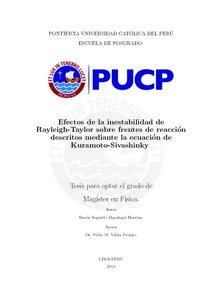| dc.contributor.advisor | Vilela Proaño, Pablo Martin | |
| dc.contributor.author | Macalupú Huertas, Simón Segundo | |
| dc.date.accessioned | 2018-06-21T23:27:02Z | es_ES |
| dc.date.available | 2018-06-21T23:27:02Z | es_ES |
| dc.date.created | 2018 | es_ES |
| dc.date.issued | 2018-06-21 | es_ES |
| dc.identifier.uri | http://hdl.handle.net/20.500.12404/12195 | |
| dc.description.abstract | En el presente trabajo se estudia la propagación de frentes químicos sujetos a la inestabilidad de Rayleigh- Taylor. El flujo convectivo es modelado utilizando la ecuación de Navier-Stokes. Los resultados serán comparados con los obtenidos con la ley de Darcy. La inestabilidad de Rayleigh-Taylor se presenta cuando dos uidos de distintas densidades separados por una delgada interfaz plana se vuelve inestable debido al gradiente de densidades que ocurre cuando el fluido más denso esta encima del menos denso y bajo la acción de la gravedad. Se consideran fluidos con las siguientes condiciones: inmiscibles, incompresibles e irrotacionales. Para describir el frente de propagación hemos utilizado la ecuación de Kuramoto-Sivashinsky(K-S) acoplada con la ecuación de Navier-Stokes para la evolución del ujo de convección.
La solución de la ecuación (K-S) ofrece una rica variedad de comportamiento espaciotemporal: frentes planos, frentes simétricos o asimétricos, frentes oscilantes y caóticos. El análisis de estabilidad lineal muestra regiones de bi-estabilidad para diferentes números de Rayleigh. | es_ES |
| dc.description.abstract | In the present work, the propagation of chemical fronts subject to Rayleigh-Taylor instability is studied. Convective ow is modeled using the Navier-Stokes equation. The results will be compared with those obtained with Darcy's law. Rayleigh-Taylor instability occurs when two fluids of different densities separated by a thin at interface becomes unstable due to the density gradient that occurs when the densest fluid is above the less dense and under the action of gravity. They are considered uid with the following conditions: immiscible, incompressible and irrotational. To describe the propagation front we used the Kuramoto-Sivashinsky equation (K-S) coupled with the Navier-Stokes equation for the evolution of the convection ow.
The solution of the equation (K-S) offers a rich variety of space-time behavior: at fronts, symmetrical or asymmetric fronts, oscillating and chaotic fronts. The linear stability analysis shows regions of bi-stability for different Rayleigh numbers. | es_ES |
| dc.language.iso | spa | es_ES |
| dc.publisher | Pontificia Universidad Católica del Perú | es_ES |
| dc.rights | info:eu-repo/semantics/openAccess | es_ES |
| dc.rights.uri | http://creativecommons.org/licenses/by-nc-nd/2.5/pe/ | * |
| dc.subject | Dinámica de fluidos | es_ES |
| dc.subject | Mecánica de fluidos | es_ES |
| dc.subject | Sistemas dinámicos | es_ES |
| dc.subject | Frentes químicos | es_ES |
| dc.subject | Métodos numéricos | es_ES |
| dc.title | Efectos de la inestabilidad de Rayleigh-Taylor sobre frentes de reacción descritos mediante la ecuación de Kuramoto-Sivashinky | es_ES |
| dc.type | info:eu-repo/semantics/masterThesis | es_ES |
| thesis.degree.name | Maestro en Física | es_ES |
| thesis.degree.level | Maestría | es_ES |
| thesis.degree.grantor | Pontificia Universidad Católica del Perú. Escuela de Posgrado | es_ES |
| thesis.degree.discipline | Física | es_ES |
| renati.discipline | 533017 | es_ES |
| renati.level | https://purl.org/pe-repo/renati/level#maestro | es_ES |
| renati.type | http://purl.org/pe-repo/renati/type#tesis | es_ES |
| dc.publisher.country | PE | es_ES |
| dc.subject.ocde | https://purl.org/pe-repo/ocde/ford#1.03.00 | es_ES |






